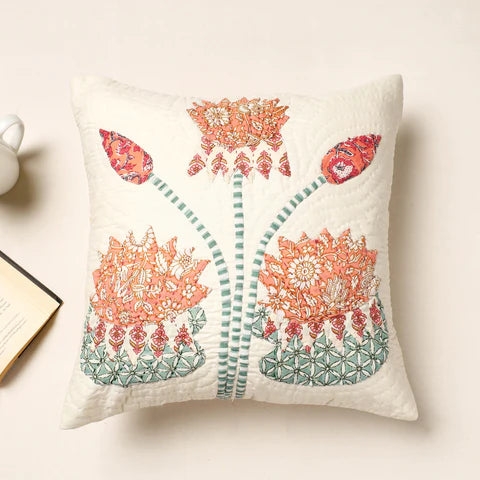Art of Quilting:-
Art of Quiting:
Diving into the History of Traditional Quilt Making.
The versatile uses of fabric make it an excellent medium that amalgamates expression, creativity and heritage. One of the oldest crafts that personifies history and impeccable creativity is the art of quilting. It entails a beautiful symphony of stitches that are used for combining different layers of fabric to provide comfort and warmth. When we talk about the history of quilting, we realise that the remnants of this craft can be found worldwide across different cultures. However, India, Europe and the Eastern subcontinent have been credited as the birthplace of this gorgeous craft.
The implications of traditional quilt-making were widely attributed to protection from the cold, but the quilting craft has evolved into an alluring form of self-expression. Over the centuries, quilting has ingrained itself in the artistic and creative legacy of different cultures and evolved globally in unique ways.
Materials for Quilting:-
Let us take a look at the materials that are required for putting together gorgeous quilt patterns:
Fabric:
The first thing you shall need will be the fabric that you want to use for quilting. Different types of fabrics such as cotton, flannel, denim, silk etc., are used for the process. Today you can even find pre-cut quilt fabric online for making designer quilts.
Batting ( the middle layer)
This is the middle layer that provides thickness, insulation and warmth to the quit.
Sewing Thread:
After that, you will need a good quality thread that can sew together the layers for making the quilted fabric.
Sewing Needles:
You will be needing needles in different sizes so that you can piece and stitch the layers properly.
Cutter And Pin:
Quilting pins and a sharp cutter are needed to cut the fabric neatly while putting together the patches. You will also need a cutting mat, a ruler, a pair of scissors, marking tools, an iron board and a sewing machine for creating a cohesive design.
Finishing, Fabric:
After that, the craftsman will require finishing fabric to neatly bind the edges of the quilted fabric to give a neat look.
Backing Fabric:
To put together the top fabric and batting layer in place, backing fabric is used. It brings symmetry and structure to the whole creation.
Some Safety Equipments:
Quilting gloves, thimbles and other safety tools are used to protect your palms and fingers while quilting.
In addition to the above-mentioned materials, you can also use various kinds of embellishments, templates etc., to add aesthetic touches to the quilted fabric.
Processe of Quilting:
An artisan follows the following process for the quilting craft:
Plan out of The Design:
Plan Out The Design
The first step is to choose the design pattern for your quilted fabric. Subsequently, choose the material and size of the fabric that you shall be using.
Prepare The Fabric:
Start by washing and ironing the fabric. After that, the fabric is cut and sewed to create desired patterns. A ruler, cutter etc., can also be used for accuracy and precision.
Put Together The Quilt Top,:
After piecing and sewing the fabric pieces together, arrange the top of your quilt.
Arrange The Layers
Arrange the top layer, batting, and back layer and put them together in place with temporary adhesives, pins or any other equipment. This idea is to prevent the layers from moving during the quilting process.
Quilting:
Stitch through the fabric, using your desired quilting design technique (more on this later). You can trim down the edges, cut down the loose threads and then any other finishing touches that you want.
Quilting the quilt
Image credit:- Wikipedia
Quilting craft is super versatile and therefore it can be moulded as per the creative inclination of the craftsmen and the intended design.
Types of Quilting,:-
There are many kinds of quilting techniques but we have put together four fundamental types of quilt patterns for your reference:
Piecing:
This quilting technique involves the use of different fabrics that are sewn together in different geometric patterns.
The intricacy of design in pieced quilts is simply exquisite.
Applique
Thai technique of quilting allows the artisan to create design patterns that have a lot of nuance. It involves the different fabric shapes that are sewn onto a base fabric. A lot of methods can be used for creating designs and shapes through applique as it entails layering of fabric.
Paper Piecing:
In this technique, the artisan pastes the fabric on a paper template to achieve accuracy of the design. After that, all the fabric pieces are sewn together and the paper pieces are taken out. At times, the craftsmen might number the pieces of paper before sewing them together to get the right design.
English Paper Piecing:
This quilting technique is much like the paper piecing method with the only exception being that the paper design templates are sewn into the design for more structure.
From the tactile art of paper piecing to the colourful world of applique, all the above-mentioned quilting methods can create bespoke quilting patterns that will greatly appeal to you.
the tactile art of paper piecing to the colourful world of applique, all the above-mentioned quilting methods can create bespoke quilting patterns that will greatly appeal to you.
Each of these quilting techniques offers a unique way to create beautiful and artistic quilts. Whether you're drawn to the precision of paper piecing or the tactile nature of hand-stitched English paper piecing, there's a technique suited to your creative style.
Conclusion:-
The art of quilting is a timeless craft that has stood the test of time and continues to thrive and evolve. The interplay of fabrics, colours and intricate patterns weaves a symphony of creativity that is bound to leave you spellbound.
Ref :-https://© 2024, iTokri आई.टोकरी




Comments
Post a Comment